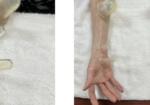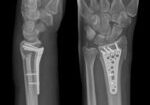¿Qué es el síndrome compartimental crónico por esfuerzo? Resumen e ideas de tratamiento con terapia de mano
archivado en Evaluación
Compartimiento El síndrome de esfuerzo crónico es una afección que se caracteriza por el aumento de la presión dentro de un compartimento del cuerpo, lo que provoca dolor, hinchazón y reducción de la perfusión tisular (Barkay et al., 2021; Buerba et al., 2019). Puede ser agudo o crónico (Barkay et al., 2021). compartimiento El síndrome de dolor suprarrenal cefálico (SCCE) es un tipo poco común, que se observa con mayor frecuencia en atletas, en particular en remeros y motociclistas cuando la extremidad superior está afectada, aunque puede presentarse en cualquier persona (Buerba et al., 2019; Cole et al., 2017). El SCCE se caracteriza por una acumulación gradual y reversible de presión dentro del compartimento, lo que provoca dolor progresivo y edema, generalmente desencadenado por la actividad. Esto se debe a la hipertrofia muscular, microtraumatismos y una fascia no distensible (Buerba et al., 2019; Ogrodnik et al., 2021). Los pacientes suelen referir dolor persistente que empeora con los movimientos repetitivos (Cole et al., 2017).
Opciones de tratamiento para el CECS
El CECS a menudo se trata de forma conservadora, aunque existen opciones quirúrgicas si los síntomas persisten e interfieren con las actividades diarias.
Tratamientos conservadores
El tratamiento conservador generalmente incluye masajes, estiramientos y modificación de la actividad (Buerba et al., 2019).
Terapia manual:
En cuanto a las técnicas de masaje y estiramiento, se ha demostrado que un programa de cinco semanas de masaje y estiramiento en casa disminuye el dolor posterior al ejercicio (Blackman et al., 1998). Un estudio concluyó que esto se debe al aumento del volumen compartimental tras el masaje debido al estiramiento fascial, o al aumento del umbral del dolor en las personas debido a alteraciones de los receptores neurales en la fascia o a cambios musculares (Blackman et al., 1998).
Biorretroalimentación:
Una forma de tratar este síndrome es brindar educación para la modificación de la actividad. Además, la enfermedad crónica... compartimiento Este síndrome se conoce a menudo como síndrome compartimental crónico por esfuerzo, ya que suele ser inducido por el ejercicio (Buerba et al., 2019). Esto se logra mediante biorretroalimentación durante intervenciones de modificación de la actividad y reentrenamiento (M. Materi, comunicación personal, 14 de septiembre de 2023; Zimmerman et al., 2017). La biorretroalimentación proporciona retroalimentación visual sobre la fuerza que ejerce un compartimento muscular (Larsen et al., 2014; M. Materi, comunicación personal, 14 de septiembre de 2023).
Figura 1: Dispositivo de biorretroalimentación mTrigger Figura 2: Dispositivo de biorretroalimentación mTrigger
https://www.mtrigger.com/biofeedback-occupational-hand-therapy/

Puños:
Además, las empuñaduras más grandes facilitarían la modificación de la actividad (M. Materi, comunicación personal, 14 de septiembre de 2023). Dado que el síndrome compartimental crónico por esfuerzo se observa típicamente en remeros y motociclistas, ocupaciones que exigen una alta fuerza de agarre y un uso continuo, crear empuñaduras más grandes podría modular la fuerza de agarre necesaria para manipular un objeto (Buerba et al., 2019; M. Materi, comunicación personal, 14 de septiembre de 2023; Sheerin et al., 2023). Cambiar las empuñaduras modificará la fuerza y la posición que el paciente ejerce en una actividad, lo que modificará el movimiento repetitivo que ha estado utilizando (M. Materi, comunicación personal, 14 de septiembre de 2023; Zimmerman et al., 2017; Schubert, 2011).
Figura 2: Mango construido

En general, el síndrome compartimental crónico por esfuerzo se puede tratar de forma conservadora, pero las personas tienen la opción de someterse a una fasciotomía si persisten síntomas que interfieren con su vida diaria.
Referencias
Barkay, G., Zabatani, A., Menachem, S., Yaffe, B. y Arami, A. (2021). Síndrome compartimental agudo de la extremidad superior: Resultados clínicos tras el tratamiento quirúrgico. Estudio de cohorte retrospectivo. Revista de la Asociación Médica de Israel, 23(8), 516–520.
Blackman, PG, Simmons, LR y Crossley, KM (1998). Tratamiento del síndrome compartimental anterior crónico por esfuerzo con masaje: Un estudio piloto. Revista Clínica de Medicina del Deporte, 8(1), 14–17. https://doi.org/
Buerba, RA, Fretes, NF, Devana, SK y Beck, JJ (2019). Síndrome compartimental crónico por esfuerzo: estrategias de tratamiento actuales. Revista de acceso abierto de medicina deportiva, 2019(10), 71–79.
Cole, A., Hiatt, JL, Arnold, C., Sites, T. y Ylanon, R. (2017). Síndrome compartimental crónico por esfuerzo en el antebrazo de un lanzador de sóftbol universitario. Medicina del Deporte – Abierto, 3(1), 11.
Larsen, CM, Juul-Kristensen, B., Olsen, HB, Holtermann, A. y Søgaard, K. (2014). Activación selectiva de compartimentos intramusculares dentro del músculo trapecio en sujetos con síndrome de pinzamiento subacromial. Estudio de casos y controles.Revista de electromiografía y kinesiología,24(1), 58–64.
Ogrodnik, J., Oliver, JD, Cani, D., Boczar, D., Huayllani, MT, Restrepo, DJ, Sisti, A., Manrique, OJ, Broer, PN y Forte, AJ (2021). Caso clínico de síndrome compartimental agudo no traumático de la mano y revisión sistemática para la extremidad superior. Mano, 16(3), 285–291.
Schubert, AG (2011). Síndrome compartimental de esfuerzo: revisión de la literatura y pautas de rehabilitación propuestas tras la liberación quirúrgica. Revista Internacional de Fisioterapia Deportiva, 6(2), 126–141.
Sheerin, M., O'Riordan, C., Conneely, M., Carey, L., Ryan, D., Galvin, R. y Morrissey, A. M. (2023). Efectividad de las intervenciones de terapia ocupacional en la función y el desempeño ocupacional en adultos con afecciones de la mano, la muñeca y el antebrazo: Una revisión sistemática y un metanálisis. Revista australiana de terapia ocupacional, 1-15.
Zimmermann, WO, Linschoten, CW y Beutler, A. (2017). Reentrenamiento de la marcha como parte del programa de tratamiento para soldados con dolor de pierna relacionado con el ejercicio: Experiencias clínicas preliminares y retención. Revista Sudafricana de Medicina Deportiva, 29(1), 1-6.
Más para leer
Dedo en gatillo… ¡Rápido y sucio!
Esto es para ustedes… ¡Terapeutas de Manos! La tenosinovitis estenosante, también conocida como dedo en gatillo, es una afección común que afecta a niños y adultos de todas las edades. Datos breves El dedo en gatillo generalmente ocurre en la polea A1 Ocurre con inflamación de los tendones y las vainas de fds y fdp El dedo puede bloquearse tanto en flexión como...
Leer másIntervenciones terapéuticas y contraindicaciones de la ventosaterapia
Por Kaylen Kallander La terapia con ventosas se utiliza para aplicar presión negativa en una zona localizada de dolor muscular o neurológico para aliviar la presión sobre los nervios y aumentar el flujo sanguíneo a la zona afectada. Esta modalidad se utiliza habitualmente en deportistas, pero también es un tratamiento frecuente en fisioterapia, terapia ocupacional o terapia de manos. Mientras que la terapia con ventosas…
Leer másUna evaluación del rango de movimiento de la muñeca y el antebrazo durante actividades y ejercicios con propósito para la fractura del radio distal
Una evaluación del movimiento de la muñeca y el antebrazo durante actividades con propósito y ejercicios de rango de movimiento después de la reparación quirúrgica de una fractura de radio distal: un estudio cruzado aleatorio Collis, J., Mayland, E., Wright-St Clair, V., Rashid, U. , Kayes, N., & Signal, N. 2022. Una evaluación del movimiento de la muñeca y el antebrazo durante actividades con propósito y rango de…
Leer másUso del ultrasonido para reducir el dolor: ¿funciona?
Ilter, L., Dilek, B., Batmaz, I., Ulu, MA, Sariyildiz, MA, Nas, K. y Cevik, R. (2015). Eficacia de la ecografía terapéutica pulsada y continua en el síndrome de dolor miofascial: un estudio controlado aleatorio. Revista Estadounidense de Medicina Física y Rehabilitación, 94(7), 547-554. https://doi.org/10.1097/PHM.0000000000000210 Reseña de: Megan Prather The Skinny- Terapia de manos con ultrasonido: se ha determinado que el ultrasonido...
Leer más¡Regístrese para recibir actualizaciones directamente en su bandeja de entrada!
Regístrese con nosotros y le enviaremos publicaciones periódicas en el blog sobre todo lo relacionado con la terapia de manos, avisos cada vez que subamos nuevos videos y tutoriales, junto con folletos, protocolos y otra información útil.






